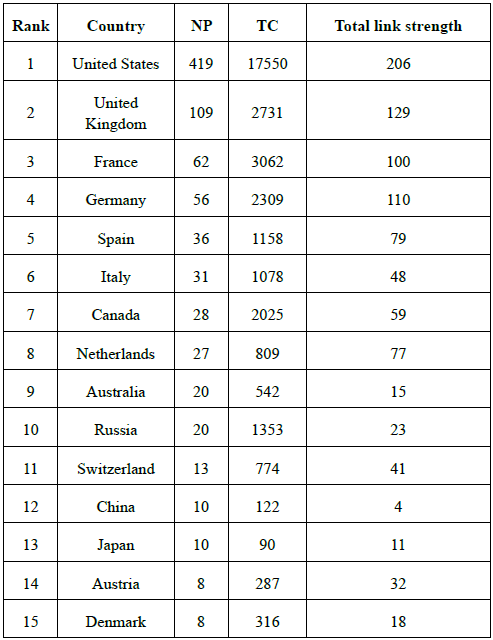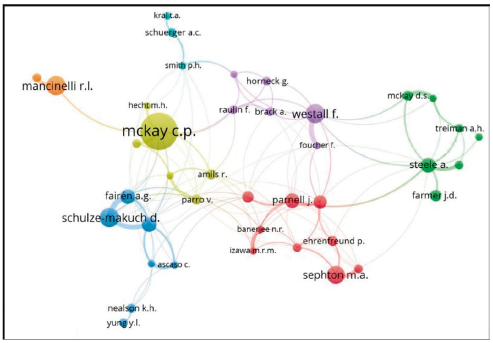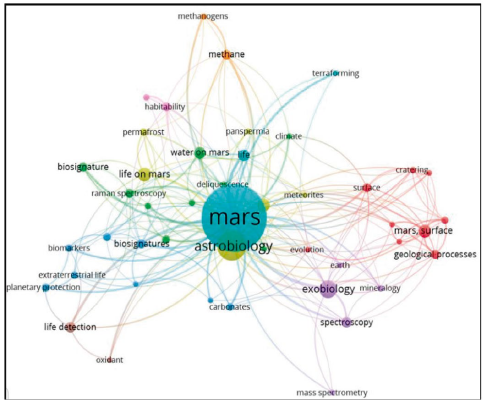1. Introduction
According to the Elsevier's abstract and citation database, Scopus, the first paper about 'Life on Mars' appeared in the scientific journal Science (Levin et al., 1962), opening the doors for a concerted multidisciplinary approach to explore another planet. In order to address the possibility of the presence of water and the existence of life on Mars, several more studies came out during the 1960s (e.g., Rea, 1963; Oyama, 1963; Shirk et al., 1965; Hawrylewicz et al., 1967). Contemporaneous to these studies, the National Aeronautics and Space Administration (NASA) successfully launched its first flyby of Mars (Mariner IV) on 28 November 1964 after a few unsuccessful attempts by the Soviet Union and NASA. Later, it captured and sent the first close-up images of Mars to Earth. The next decade (the 1970s) highlighted the successful launch of Viking 1 and Viking 2 landers in 1975 that provided important information about the atmosphere and surface of Mars with no conclusive evidence regarding the existence of life on the planet (Levin and Straat, 1976). In addition to the use of remotely controlled unmanned aerial vehicles (UAVs) for Mars exploration (Sharma et al., 2022 and refs. therein), detailed investigations of meteorites have provided a complimentary understanding of Mars. Up till the early 1980s, some meteorites were thought to be of Martian origin due to their chemical composition matching that of the Viking lander's analyses (Levin and Straat, 1976) and differences in geochemical characteristics from other common groups of meteorites. Bogard and Johnson (1983) provided direct evidence of a link between these anomalous meteorites and Mars after analyzing the trapped gasses in impact-related glass from the Elephant Moraine 79001 (EET 79001) meteorite collected by ANSMET (i.e., US Antarctic Search for Meteorites program) in Antarctica. The obtained compositions from these gases (e.g., argon, krypton, xenon) closely resembled those of the Martian atmosphere analyzed by the Viking landers (Bogard and Johnson, 1983). Martian meteorites are rare (i.e., as of 28 July, 2022, the Meteoritical Bulletin Database contains 335 samples registered out of 69949 = 0.48%) compared to other common types and have so far provided important clues about water and life on Mars (e.g., McKay et al., 1996).
After launching flybys and landers, in the mid-1990s (4 December 1996), NASA successfully launched its first Rover (i.e., a wheeled vehicle), Sojourner, which was in a Lander called Pathfinder to take the Martian exploration to the next level. Since then, other Rovers, including Spirit (10 June 2003), Opportunity (8 July 2003), and Curiosity (26 November 2011), have also made successful landings on Mars. All these missions have provided an unparalleled understanding of the Martian geology and landscape.
Our motivation for the present study is the recent launch and landing of NASA's Perseverance Rover, also known as Mars 2020, designed specifically to search for microbial life on Mars and to store sample cores in tubes on the Martian surface for future sample return missions. With the exciting current and future developments in Mars research and prospects of human habitability on Mars, it is vital to evaluate the history and impact of the research on LoMars using statistical (i.e., bibliometric) methods. In the present study, we provide a literature overview of the LoMars research with the main emphasis on bibliographic variables including author(s), source journal, subjective keywords as well as citation scores (Young and Belanger, 1983) and recognize the most prominent articles, authors, journals, collaborations, and growth trends.
2. Methodology
Literature search, data extraction and analysis
A literature collection was initiated with a wide-ranging search of relevant articles on LoMars. The initial step was to determine appropriate databases, which would provide a full range of published articles on LoMars. Elsevier's Scopus (ESc), an extensive database containing peer-reviewed literature, was used for bibliographic information of each document along with other publishing information necessary to carry out citation analysis of the fields relevant to LoMars articles. In addition, ESc has a wider article coverage than other web sources, thus being most suitable for our objective to extract as much relevant information as possible. Abstracts, titles and keywords were searched using a comprehensive list of important words used by the researchers involved in the literature on LoMars. The following final Boolean search has been carried out in ESc during August 2020, after the launch of Mars 2020 Perseverance Rover by NASA, and later updated on March 14, 2021: TITLE-ABS-KEY (("Life on Mars*" OR "Martian life*" OR "water on Mars*" OR "Martian Soil*" OR "SNC meteorites*" OR "Shergottite-Nakhlite-Chassignite*" OR "Shergottite Nakhlite Chassignite*" OR "Shergottites*" OR "Nakhlites*" OR "Chassignites*" OR "Martian meteorites*"). This method yielded more than seven thousand documents. In order to extract relevant articles, several filters were applied; we kept only English journal articles while removing books, book chapters and conference proceedings. Following the application of all these filters, as well as the manual removal of irrelevant articles, the final sample contained 660 articles published between 1962 and 2020. The academic data file records, such as the publication over time, authors' production over time, authorship, institutions, countries, journals, publication count, keywords, institution collaborations network and citation count were extracted from the Scopus database. The downloaded data file (full records and cited references) were exported into the R-based Bibliometrix interface, which is widely used for citation analysis (Marty et al., 2020; Aria and Cuccurullo, 2017). These articles have been published in diverse peer-reviewed research journals, written by single or multiple authors from numerous countries. The VOSviewer program was used to construct the network analyses between citation, country, and authors' collaborations (Perianes-Rodrigues et al., 2016).
3. Results and Discussion
Overall results
Eleven search strings were used to find the 660 documents on LoMars research, which have been cited 22,242 times based on the average number of citations per document (33.7). More than two-thousand authors (2006) have been identified in these documents, averaging three authors per document. The annual number of articles began to rise in the mid-1990s and continued to rise until 2002, at which point it mostly remained below thirty publications per year, with the exception of2003 (35), 2011 (33), and 2019 (34) (Figure 1). The introduction of the first Rover, Sojourner (4 December 1996), may have contributed to the increase in the number of publications in the 1990s. Similarly, spikes in the number of articles published in 2003 and 2011 could be attributed to the launches of NASA Rovers such as Spirit (10 June 2003), Opportunity (8 July 2003), and Curiosity (26 November 2011). Presumably, the exceptional features of the Perseverance Rover in comparison to previous rovers will result in a higher publication throughput in the future, and the spike in 2019 could be the start of yet another surge in LoMars research as previously seen in the 1990s (Figure 1). Out of the twenty-three publications in 1998 (Figure 1 inset), the only two articles cited more than a hundred times in 22 citable years (i.e., CY) were Jakosky and Shock (1998), and Sleep and Zahnle (1998), with the mean total citations per article (i.e., MTCpA) and mean total citations per year (i.e., MTCpY) equal to 32.9 and 1.5, respectively (Figure 2). When compared to years with NP > 20 per year, the years 2000 (CY = 20) and 2015 (CY = 5) have the highest MTCpA (74.9) and MTCpY (6.3) values (Figure 2). Four of the twenty articles published in 2000 (CY = 20, Figure 2) were cited more than 150 times (Yen et al., 2000; Skidmore et al., 2000; Benner et al., 2000; Wynn-Williams and Edwards, 2000), which could explain the higher MTCpA (75). A paper on hydrated salts on Mars (Ojha et al., 2015) has been cited over 300 times, giving the year 2015 the highest MTCpY value (6.3). The same paper is also one of the top ten most cited publications in terms of average number of citations per year (i.e., APYC; see Table 1).
Table 1 A summary of the top ten highly cited articles on LoMars research. Abbreviations: R = article rank. TC = total citations. APYC = average per year citations. PY = publication year. 5YIF = 5-year impact factor. JGR = Journal of Geophysical Research. EPSL = Earth and Planetary Science Letters.
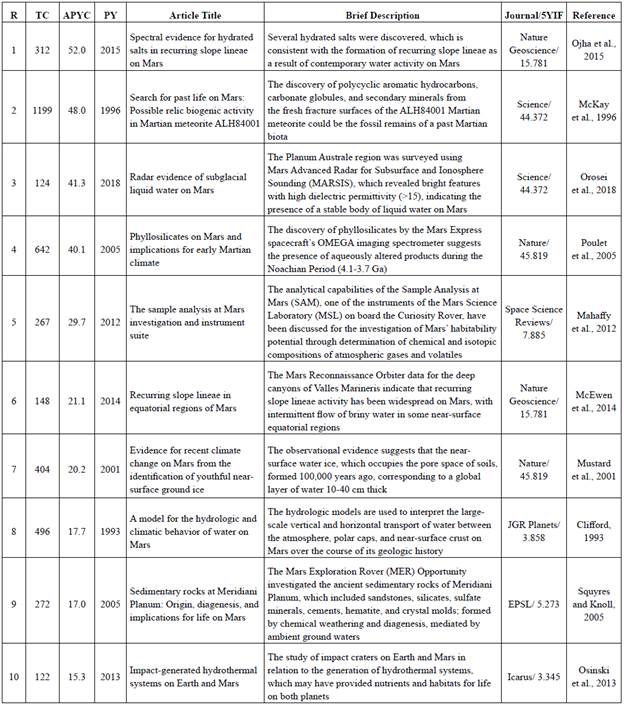
Table 2 A list of the top 10 most influential authors who have published the most papers on LoMars research. Abbreviations: NP = number of publications. TC = total citations.
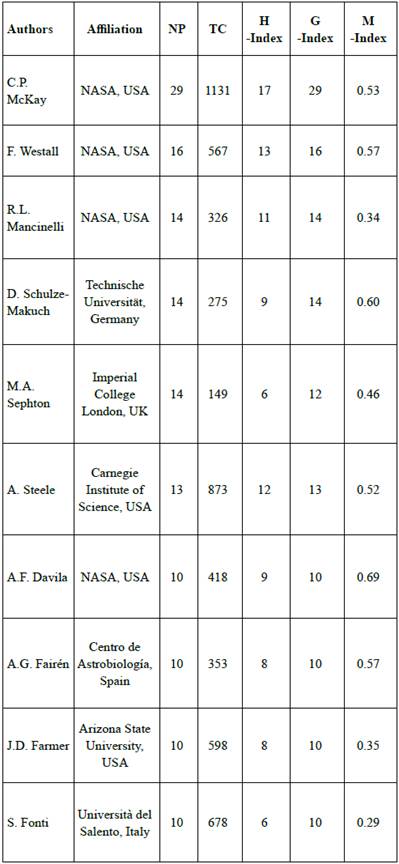
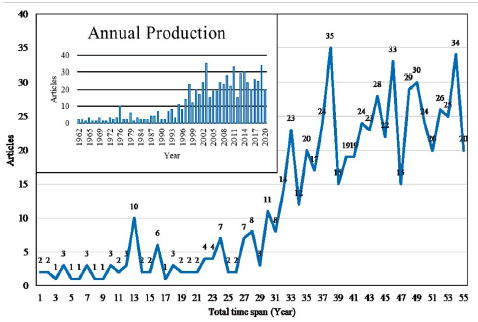
Figure 1 Plot showing the annual number of articles published on LoMars research from 1962 to 2020. The inset bar graph depicts the gradual increase in annual output since the early 1990s. The numbers next to each kink represent the number of articles published during that specific year.
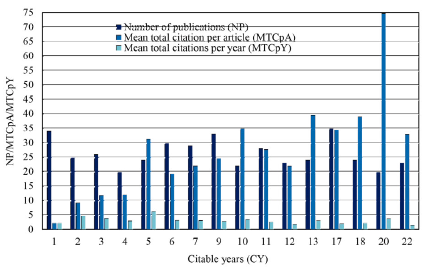
Figure 2 Plot of the number of publications (NP), mean total citations per article (MTCpA), and mean total citations per year (MTCpY) against the number of citable years (CY).
It is important to keep in mind that interesting studies may have been published in non-Elsevier journals, and particularly in non-English journals. This may certainly be true for studies, in particular, published in Russian, Japanese, and Chinese journals, which might influence the statistics.
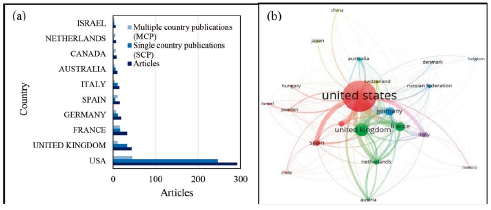
Figure 3 (a) Comparison of LoMars research articles with corresponding authors from different countries, affiliation of co-authors from a single country (SCP), and affiliation of co-authors from multiple countries (MCP). SCP = Single Country Publications. MCP = Multiple Country Publications. (b) Comparison of top-cited countries with a minimum of five citations. Most of the G7 countries (United States, Japan, Germany, the United Kingdom, France, Italy, and Canada) ranked in the top ten.
Analysis of prominent Authors and Countries
The productivity of LoMars researchers has been assessed using H-, G-, and M-indices, which are based on the number of citations (Table 2). Six of the top ten most renowned authors are Americans (the majority of whom work for NASA; Table 2), while the remaining four are from European countries such as the United Kingdom, Germany, Spain, and Italy (members of the G7 countries). In terms of the total number of publications, total citations, H-, and G-index, C.P. McKay is firmly ranked in first place among the top ten authors (Table 2). However, because the author has been active for over 30 years, the M-Index (i.e., H-Index divided by the number of years the scientist has been active) is lower. In addition, the United States leads the world in two categories: Multiple Country Publication (MCP) and Single Country Publication (SCP) (SCP; Fig. 3a). As evidenced by the highest number of documents for the MCP category (i.e., an indicator for collaborative research; Figure 3a), NASA ranks sixth on the list of the world's most collaborative institutions (Nature Index 2016), indicating the United States' dominance in collaborative research (i.e., total link strength) in the field of LoMars in particular and planetary research in general (Table 3). Furthermore, the United States ranks first among highly cited countries in LoMars research (Figure 3b).
Collaborative Research Analysis
Despite a significant difference in the number of documents published as MCP (i.e., co-authors' affiliations are in different countries) and SCP (i.e., all authors' affiliations are in the same country), the United States remains the top-ranked country in terms of the corresponding author's affiliation (Figure 3a). If the MCP is used as a proxy for collaborative research, the United States would be the most collaborative country in LoMars research (Figure 4). The majority of the other top-ranking countries are G7 members, supporting the idea that scientific collaborations are inextricably linked to scientific infrastructure, basic research, and collaborative publishing output.
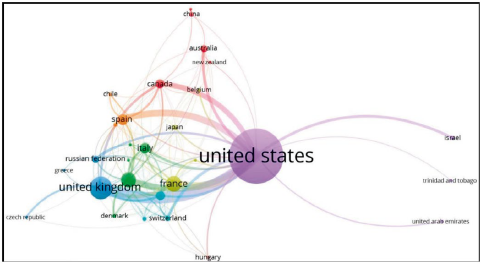
Figure 4 Comparison of collaborative research in LoMars, with a minimum of two articles published. The United States is the main international collaborator on LoMars research, particularly in Europe and Asia. The majority of the G7 countries (Japan, Germany, the United Kingdom, France, Italy, and Canada) ranked in the top ten.
For instance, China has been leading the G7 countries in terms of publications since 1996 (He, 2009), despite the fact that it was not previously prominent in LoMars research (Figure 4). The author emphasized that political, economic, educational, and scientific policies have successfully transformed the country into a world giant in international scientific publications. Collaborative work, which is one of the most important aspects of modern research, opens up international opportunities for scientists, as evidenced by the exponential growth of international collaboration publication output between China and G7 nations (He, 2009).
Evidently, the majority of African and Asian nations' contributions to LoMars research are either absent or insignificant (Figure 4). However, a few African and Asian countries have recently emerged as leaders in the field of planetary sciences. For instance, the Japan Aerospace Exploration Agency (JAXA)and the United Arab Emirates (UAE) jointly launched the Hope Probe on July 19, 2020. On February 9, 2021, the probe was successfully placed into Mars orbit, only days before the Mars 2020 Perseverance Rover landed on the Martian surface (https://www.emiratesmarsmission.ae/). The Hope Probe will investigate various aspects of the Martian atmosphere for the first time in order to provide a complete compositional picture using cutting-edge instruments such as the Emirates Mars Infrared Spectrometer (EMIRS), Emirate Exploration Imager (EXI), and Emirates Mars Ultraviolet Spectrometer (EMUS). Furthermore, the China National Space Agency (CNSA) launched China's first interplanetary mission, the Tianwen-1 robotic spacecraft to Mars, on July 23, 2020, which successfully entered the Martian orbit on February 10, 2021 to examine the target site for a rover landing on May 14, 2021. This rover's scientific goals include studying Martian geology with a focus on the planet's interior structure; identifying minerals and rocks; examining the atmosphere; and looking for evidence of water using 13 scientific equipment (https://en.wikipedia.org/wiki/Tianwen-1). As a result of these missions, the number of international collaborative research publications (i.e., MCP) on LoMars and related themes could increase exponentially in coming years.
International collaborations have lately been proven to be ineffective unless an underdeveloped partner has some local research capabilities to benefit from the developed counterpart (Scarazzati and Wang, 2019). Collaborative research is typically based on partners exchanging knowledge, skills, and techniques, resulting in economic progress and growth (Luukkonen et al., 1992; Katz and Martin, 1997). In contrast, partners with more advanced scientific fields do not seek the same kinds of collaboration as partners with less advanced fields (Scarazzati and Wang, 2019). According to reports, the planetary and space sciences (PSS) potential in Africa has largely remained untapped due to the common misconception in African countries that funding fundamental science costs society more than it benefits (Baratoux et al., 2017). Despite the emergence of PSS in Africa through the launch of several PSS projects for regional research capacity building, research groups remain dispersed and underfunded. The publication survey (2000-2015) reveals that Africa has published less than 1% of the worldwide output of scientific articles published in the four PSS representative journals (viz. Icarus, Journal of Geophysical Research: Planets, Journal of Geophysical Research: Space Physics, and Meteoritics & Planetary Science), despite Africa making up more than 15% of the world's population (Baratoux et al., 2017). However, there have been numerous PSS advancements across Africa that show promise for the future and the growth of PSS-related basic science. For instance, both the South African National Space Agency and South African Astronomical Observatory are active in the PSS sector. The largest radio telescope in the world, the Square Kilometre Array (SKA), will soon be established in the Australian and South African deserts (Baratoux et al., 2017). Morocco has become well-known for various meteorite discoveries and impact studies (Chennaoui Aoudjehane et al., 2016), attracting international scientists through conferences and outreach activities (e.g., Space Bus Morocco). Furthermore, the Ibn Battuta Center and the first astronomical observatory in Marrakech have been established to test instruments related to Martian exploration and meteorite impacts on the moon (Ait Moulay Larbi et al. 2015), as well as the search for exoplanets (Benkhaldoun et al., 2005; Gillom et al., 2017). Algeria is also focusing on meteorites and impact craters with the support of international collaboration (Lamali et al., 2016; Sahoui et al., 2016). Since 2015, the Arabian Geosciences Union has launched a special section on planetary science and astrobiology for PSS scientists across northern Africa and the Middle East. The Sultanate of Oman, which has been the site of numerous meteorite discoveries (Ali et al. 2017a, 2017b), including Martian meteorites like Dhofar 019, Sayh al Uhaymir (SaU) 005, and SaU 008 (Ali et al. 2016, 2017c, 2018), can act as a catalyst for regional collaboration to promote PSS.
The most collaborative author on LoMars research (C.P. McKay; Figure 5) has recently discussed five prerequisites for detecting life on other bodies in space, including Mars (McKay, 2020). This author identified the following compelling evidence to be targeted in the pursuit of the search for life beyond planet Earth: i) signs of liquid water of suitable salinity, ii) carbon in the water, iii) biologically available nitrogen in the water, iv) biologically useful energy in the water, and v) organic material that can possibly be of biological origin and an applicable sampling strategy for this material.
Analysis of Productive Journals
According to Bradford's law (the estimation of exponentially decreasing returns from searching for references in scientific journals), 162 journals have been classified into three categories (representing 4, 16, and 142, respectively), with roughly one-third of all the publications (i.e., 229, 215, and 216) in each category (Figure 6a). Icarus, Astrobiology, Planetary and Space Science, andAdvances in Space Research are the four core journals in Zone 1. These journals jointly published 229 papers (Figure 6a), which were cited 3698 times (Figure 6b). The total number of citations in zones 1, 2, and 3 is distributed in increasing order as 3698 < 5302 < 13239, respectively (Figure 5b). However, the average number of citations per journal in each category is in the order of 925> 331> 93, respectively.
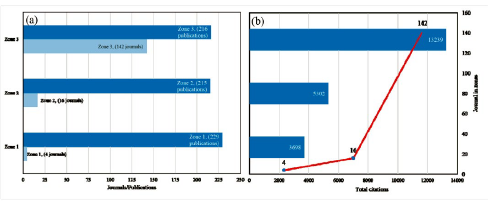
Figure 6 (a) Distribution of scientific journals according to the Bradford's Law distribution of journals in categories; number of publications in each category; and (b) total citation share of each category. Note that core journals in Zone 1 (Icarus, Astrobiology, Planetary and Space Science, Advances in Space Research) published 34.7% of the total articles.
Table 4 The ranking of top-15 most productive journals for LoMars research based on the number of publications (NP). Other parameters, including percent publications (%P), total citations (TC), and H-, G-, and M-indices are given for reference.
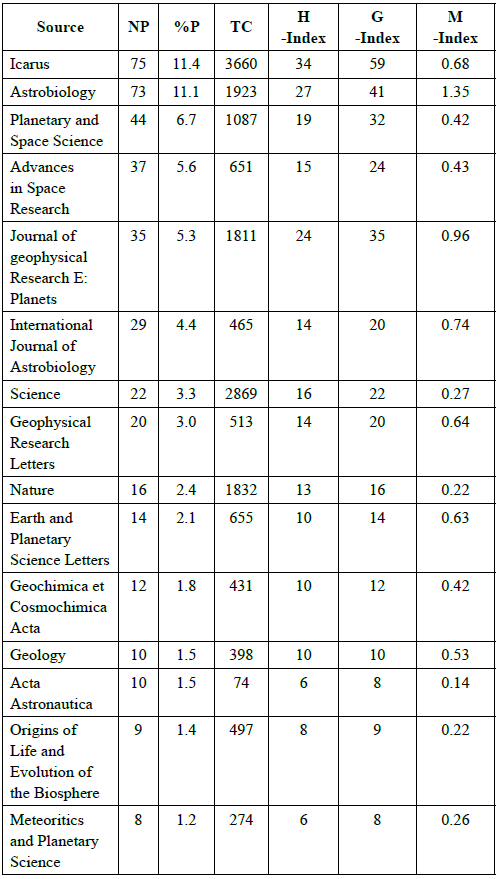
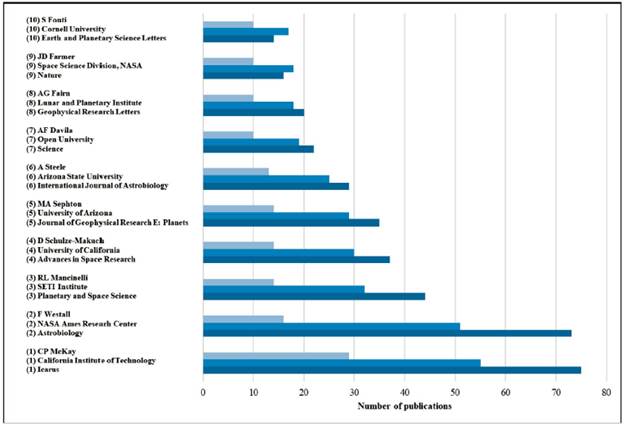
Figure 7 The top ten highly influential journals, institutes, and authors based on the total number of publications in LoMars research.
Among the journals listed in Table 4, Icarus is one ofthe oldest, following Science and Nature. The top-15 journals have published 62.7% of all LoMars research articles. Icarus (11.4%) is the most productive journal, just ahead of Astrobiology (11.1%). The journal Icarus leads in all categories, including the number of publications (NP), citations (CT), the H-, and G-Indexes, but not the M-Index (H-Index divided by the number of years since it published its first paper on LoMars), because it began publishing on LoMars in 1971 (Table 4).
Based on the total number of publications related to the LoMars research, the top ten lists of journals, institutes, and authors are compared in a bar diagram (Figure 7). The number of articles associated with the journals, institutes, and authors ranges from 14 to 75, 17-55, and 10-29, respectively. There is a close competition between the top two spots for Icarus (75) and Astrobiology (73), as is seen at the California Institute of Technology (55) and NASA Ames Research Center (51). However, CP McKay (29) is leading in front of F Westall (16) by a substantial margin. Therefore, Icarus (75), the California Institute of Technology, and C.P. McKay have been recognized as the most influential journal, institute, and author, respectively (Figure 7). Elsevier's journal Icarus, with a 2021 impact factor of 3.508 (Clarivate Analytics, 2022), is primarily focused on the publication of original contributions in the field of Solar System studies. Caltech established the Jet Propulsion Laboratory (JPL) in the 1930s, and NASA has managed it since 1958. C.P. McKay, the highly influential author of LoMars research, is a senior scientist at NASA.
Keywords Analysis
According to Figure 8, the top five keywords (Mars, astrobiology, exobiology, Mars' surface, life on Mars) are directly related to Mars and the study of Martian life. The Mars 2020 Rover was specifically designed to study past and present life on Mars, and future sample return missions are critical to understanding LoMars. So far, meteorites have been investigated for this purpose, but because oftheir journey under severe conditions, some physical changes occur to their surface (i.e., fusion crust) due to fictional heating followed by possible terrestrial contamination. Thus, pristine samples returning from Mars' surface and subsurface are predicted to introduce keywords such as surface, mineralogy, carbonates, habitability, and climate in the future (Figure 8).
4. Conclusions
The search for life on other planets, particularly Mars, has been going on since the mid-twentieth century, with articles published in prestigious scientific journals beginning in the early 1960s. Based on bibliometric analysis using Elsevier's Scopus database, 660 articles on life on Mars (LoMars) research have been published by over 2000 authors and have been cited over 22,000 times, averaging 33.7 citations and 3 authors per article. Furthermore, lists of highly cited authors, most productive authors, institutes, and journals are identified based on citations and number of publications. According to these lists, C.P. McKay, Caltech, and Icarus emerged as the most productive author, institute, and journal, respectively. The highest ranked author and institute are both affiliated with NASA, demonstrating the organization's dominance, which, however, is challenged by the recent launches of missions to Mars by organizations from other nations, particularly, the China National Space Agency (CNSA). Using multiple nation co-authorship as an indicator of collaborative research, the United States has dominated the world to date due to the availability of infrastructure and human scientific resources. Recent collaborative initiatives among Asian and African nations have broadened the field of planetary and space sciences.
The rate of scientific publications has been found to be closely linked with NASA's launch of various rovers. We used this tendency as a proxy to predict that future LoMars research will grow following the recent landings of NASA's Mars 2020 Perseverance Rover and China's Zhurong Rover. Parallel missions launched by the UAE Space Agency in partnership with JAXA would perpetuate this trend. The findings of observational and theoretical research are reported in majority of the top-cited papers. However, the highly cited paper by D.S. McKay et al. (1996) is based on analytical studies of a unique Martian meteorite (i.e., Allan Hills 84001), implying that the future sample return mission associated with the Perseverance Rover could potentially enhance LoMars research. The study of pristine samples from Mars' surface and subsurface would influence the keywords selection seen in previous papers.













